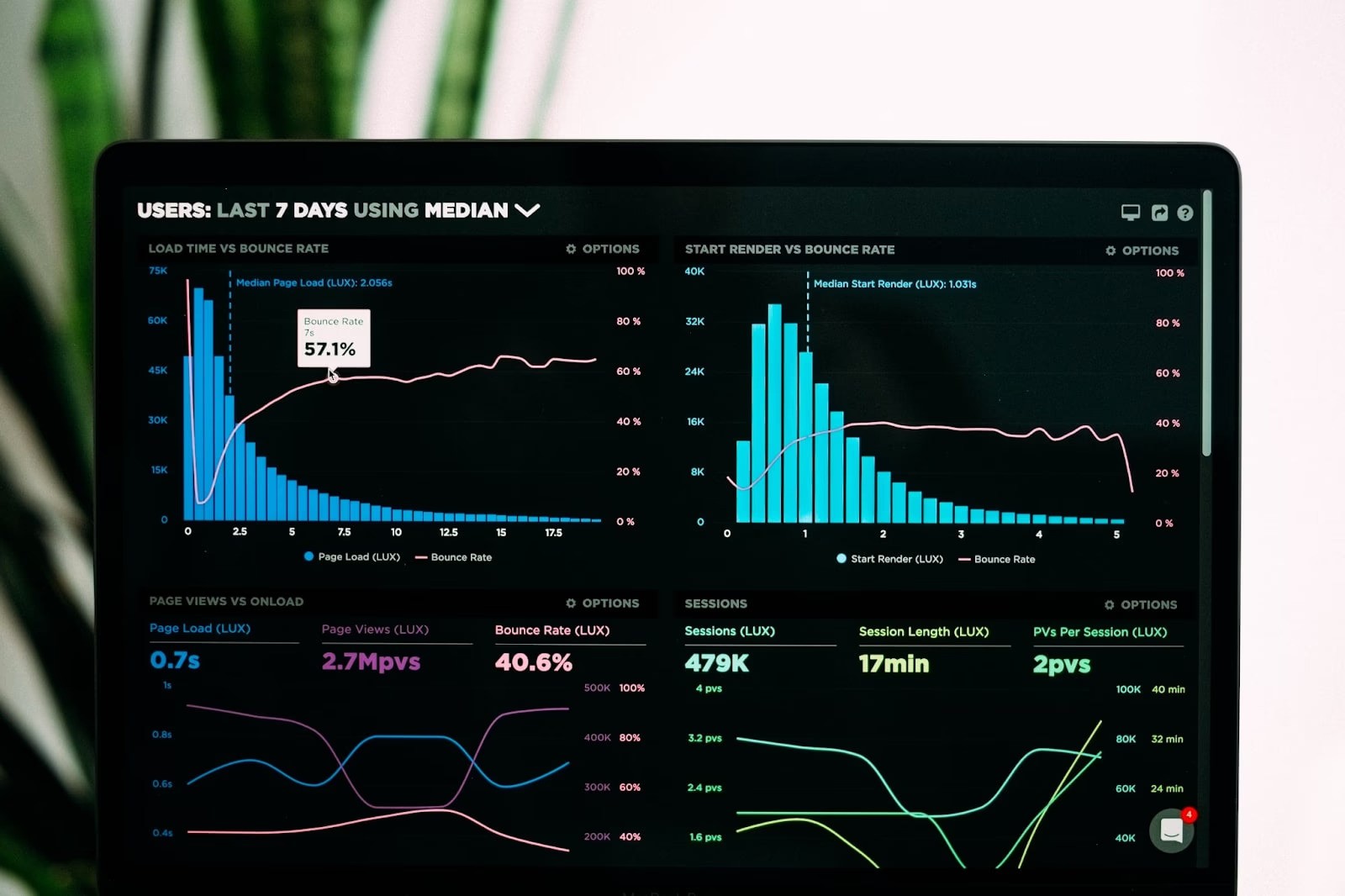
Merve Nur Yalçın Uslu
8 Min Read
Discover how to streamline your data flow and empower users with seamless dashboards tailored for impactful decision-making.
Introduction
It's tough to picture an app these days without a dashboard. They're everywhere, even showing up in our phone settings to help us monitor things like device health and battery use. However, in the past, dashboards might have been an afterthought to please higher-ups, making a web dashboard app today is a whole different ball game—it's challenging and vastly different. In today’s article, we are going to focus on building effective dashboards and Web Apps. Let’s dive in without wasting any time!
Contents
Definition of Dashboards and Web Apps
Importance of Dashboard and Web Apps
How To Build an Effective Dashboard
Dashboard’s Name Is Crucial
Creating Efficient Web Apps
In Conclusion
Let’s dive in!
Definition of Dashboards and Web Apps
A dashboard is like a one-stop display for different types of visual information. It's meant to show various, but related, pieces of info in an easy-to-understand way. This often includes important business stuff, like key performance indicators (KPIs), which help important people quickly get what they need to know.
Dashboards are super useful in many industries because they can be changed a lot to fit different needs. They can handle all sorts of data from different time periods, helping to figure out what happened before, why it happened, what might happen next, and what needs to be done. Using graphs, tables, and charts makes it easier for everyone, even those not super familiar with the data, to understand what's going on and get important insights.
On the other hand, a web application, simply put, is like a program that lives on a faraway computer and you use it through the internet on a web browser. Some websites have these programs, but not all. They're made by tech folks for different purposes. They can do a bunch of stuff like help you with emails, do math for you, or let you shop online. While a few might work only on certain web browsers, most of them work fine no matter which browser you use.
In today’s digital world, it is crucial to use these two things effectively. Do you know what we mean by "effective"? Let’s take a closer look.
Importance of Dashboard and Web Apps
In the world of successful businesses, a key component is a management team that's always in the know. These leaders are quick to highlight that staying updated on key performance indicators (KPIs) plays a pivotal role in their achievements. Having real-time access to these KPIs empowers them to act proactively, nipping potential issues in the bud before they wreak havoc on the company's profits.
Dashboards are their go-to tool for managing KPIs. These simple software applications gather data from different parts of the company and present it in easy-to-understand charts and graphs.
The beauty of dashboards lies in their ability to simplify complex data. Instead of wading through endless spreadsheets and detailed reports, these visual representations save heaps of time and facilitate prompt decision-making—a critical asset in today's cutthroat business landscape. Thanks to technological advancements, businesses can now swiftly create custom-designed dashboards without hefty investments. These personalized dashboards focus on the most crucial KPIs, providing real-time insights and enabling businesses to make well-informed decisions on the fly.
On the other hand, information from newsletters and application forms needs to be collected and processed for future use. Web applications, like submission fields, inquiry forms, shopping carts, and content management systems, handle this task on websites. They're like tools that make it happen. These web applications help businesses have a strong online presence, which helps them connect better with customers. That's why they're becoming more and more popular—they're a big deal in today's digital world and their popularity keeps growing.
How To Build an Effective Dashboard
One thing is evident: Dashboards are designed to convey key goals using straightforward metrics to your team. It's crucial to keep in mind that unless the dashboard is clear and easily understandable, it won't be utilized or comprehended. To assist you in getting started and heading in the right direction, we've compiled a checklist for creating effective dashboards.
When initiating the dashboard-building process, focus primarily on the question: What do you aim to accomplish with your dashboard? What is the primary purpose of this dashboard? Who is the intended user, and how should they respond to the data and when?
The key idea is that the dashboard you are constructing should communicate something relevant, something meaningful. Therefore, ensure that your presentation is coherent and clear, enabling your team to comprehend what they should observe in the dashboard and how to interpret that information.
Once you've determined the message you want your dashboards to convey to your audience, ensure clarity in your presentation. Define a straightforward research question for the dashboard and express it in simple terms. For instance, if you're creating a category management dashboard, include data on category sizes, average prices, and prominent brands. It's crucial to maintain a focus on addressing the specific questions related to the category. Avoid incorporating data on unrelated subjects like campaigns, offers, or new products, as it can divert attention from the primary focus.
Dashboard’s Name Is Crucial
Start by giving your dashboards clear names. The clearer the name, the easier it is to understand. Consistency in naming across all dashboards helps people know what to expect and puts them in the right mindset.
Staying on topic means focusing on the main points, not drowning your audience in details. A good rule of thumb is to limit your insights to five points at most. Too much information can confuse and lose your audience's interest. In each dashboard, prioritize the main idea in the first two widgets. This helps users dive into the content more smoothly. Use various visualizations to highlight the same point. For example, represent average prices on a category level with a grouped price matrix and display price spreads using a box plot. This approach immediately clarifies whether the average price is consistent or scattered across different levels. If we've erased the question marks in your mind, let’s talk about how you can create effective Web Apps.
Creating Efficient Web Apps
In an era where digitalization continues to grow, web applications play a pivotal role in transforming various industries. Businesses are increasingly focusing on the development of web apps to enhance user interactions with their products and services in 2023.
In the competitive market, it is essential to capture market segments by maximizing user engagement. Customizable web apps offer an effective way to achieve this by enabling users to interact with services/products directly through a web browser.
Web apps serve as a crucial link between users and products/services, serving purposes such as customer management, inventory control, and analytics reporting. It is imperative to ensure that web applications effectively engage consumers, providing satisfaction by helping them achieve their goals.
Despite the global complexity of web app development, which has been prevalent for three decades, the programming intricacies have led to simplified user functions. Here are some efficient tips for successful web app development:
Naming and Consistency: Ensure your dashboards have clear names for easy understanding. Maintain consistency in naming across all dashboards to set expectations and create a cohesive user experience.
Focus on Main Points: Stay on topic by visualizing the main points in your dashboards. Avoid overwhelming users with unnecessary details, as it can lead to confusion.
Limit Insights: Keep insights to a maximum of five points per dashboard. Too much information can risk losing the audience's interest and attention.
Prioritize Main Ideas: Place the main focus idea in the first two widgets of each dashboard to guide users into a deeper understanding.
Diverse Visualizations: Use different visualizations to convey the same point, providing varied perspectives. For example, represent average prices with a grouped price matrix and price spreads with a box plot.
By implementing these strategies, you can enhance the effectiveness and user-friendliness of your web applications.
In Conclusion
Dashboards serve as one-stop displays, simplifying complex data and providing quick access to key performance indicators (KPIs). The real-time insights they offer empower management teams to make proactive decisions, crucial for success in today's competitive business environment. The beauty of dashboards lies in their ability to streamline information, saving time and facilitating prompt decision-making.
On the other hand, web applications, as remote programs accessed through web browsers, play a pivotal role in connecting businesses with users. They handle tasks such as data collection, inquiry forms, and content management, contributing to a robust online presence. The popularity of web applications continues to grow, making them indispensable in the digital world.
In this digital world, the effective integration of dashboards and web applications is essential for businesses aiming to stay competitive and meet the evolving needs of users. By following best practices and adopting a user-centric approach, developers can create impactful and successful solutions that contribute to the overall growth and success of businesses in 2024 and beyond. If you want to benefit from a professional service on effective dashboards and web apps, be sure to contact VIZIO.AI.
If you like this article, you can check out our other articles.





